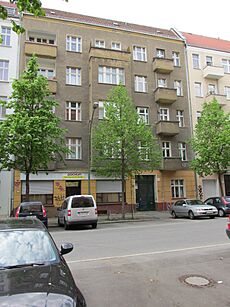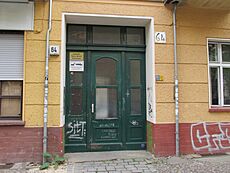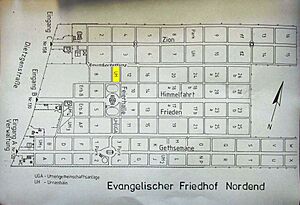Hildegard Trabant facts for kids
Quick facts for kids
Hildegard Trabant
|
|
|---|---|

Trabant's photo at the Berlin Wall Memorial
|
|
| Born |
Hildegard Johanna Maria Pohl
12 June 1927 |
| Died | 18 August 1964 (aged 37) East Berlin, East Germany
|
| Cause of death | Shot by a guard whilst attempting to enter West Berlin from East Berlin |
| Body discovered | Closed S-Bahn tracks between the Schönhauser Allee and Gesundbrunnen stations 52°32′58″N 13°24′07″E / 52.549483°N 13.401828°E |
| Resting place | Friedhof Nordend, Berlin-Rosenthal |
| Monuments |
|
| Known for |
|
| Political party | SED |
Hildegard Johanna Maria Trabant (born Pohl; 12 June 1927 – 18 August 1964) was a woman from East Germany. She became the fiftieth known person to die at the Berlin Wall. East German border guards shot and killed Trabant when she tried to cross the border. She was one of only eight women who died at the Berlin Wall. Interestingly, she was also the only person trying to escape who was known to have been loyal to the East German government.
Life in East Berlin
Hildegard Pohl was born in Berlin on June 12, 1927. She grew up in the city. She was loyal to the East German government. In 1949, when she was 22, she joined the ruling Socialist Unity Party. She was seen as an active member of the party.
In 1954, she married Günter Horst Trabant. He was a People's Police officer who worked in the passport and registration department. Hildegard and Günter did not have any children. They lived in an apartment building on Tilsiter Straße 64. This street is now called Richard-Sorge-Straße. Their home was in the Friedrichshain area of East Berlin, close to the Frankfurter Tor subway station. Hildegard also worked as a property manager for the local housing office in Friedrichshain.
Her Death at the Berlin Wall
On August 18, 1964, Günter Trabant told his office that his wife had been missing since the morning of August 17. He also said some of her clothes were gone. Later that day, at 6:50 in the evening, Hildegard Trabant was shot while trying to cross the border. She was trying to get from East Berlin to West Berlin.
Trabant tried to leave using an old, unused S-Bahn train line. This line ran between the Gesundbrunnen and Schönhauser Allee stations. She managed to get over the first part of the wall. However, East German border guards found her hiding behind some bushes before she reached the other side.
The guards told her to come out and give up. But she did not listen. Instead, she ran back towards the inner wall and East Berlin to avoid being arrested. One of the guards fired a warning shot to make her stop. When she kept running, a second shot hit her in the back. Hildegard Trabant died about an hour later at the Police Hospital. She was 37 years old.
It is not known why Trabant decided to leave East Germany. Her husband, Günter, did not explain the situation to his superiors or the Stasi (secret police) officer.
Hildegard Trabant was one of only eight women killed at the Berlin Wall. At least 140 people died there in total. She was also one of only four women who tried to cross the wall alone. Out of at least 101 Berlin Wall victims who were trying to escape, she was the only one known to have been loyal to the East German government.
Burial Site
Hildegard Trabant was buried on September 23, 1964. Her burial took place at the Frieden-Himmelfahrt Cemetery. This cemetery is now called the Evangelischer Friedhof Nordend. It is located north of Pankow, in Rosenthal.
She was buried in a "linear grave." This type of grave was only allowed for 20 years under East German law. After this time, the grave's right to exist expired unless it became a family grave. Her grave's period ended in 1984. This part of the cemetery was then changed. Her urn is still there, like all urns buried in that area. However, it is now under a different grave number and a different name on the tombstone. Her old grave number was UH Him – 234a, and the new one is UH Him – B102.
Aftermath and Legacy
Unlike most other deaths at the Berlin Wall, Hildegard Trabant's death was not known in West Berlin at the time. It was only 26 years later, after Germany was reunited in 1990, that her story became known. In October 1990, the East Berlin files from 1964 were given to the German courts.
After a long trial, Kurt Renner, the guard who shot her, was found guilty. He was sentenced to one year and nine months in prison, but this was later changed to a suspended sentence. It was clear that when she was shot, she had given up her attempt to escape East Berlin. She was simply running back towards the inner wall to avoid being arrested.
See also
- List of deaths at the Berlin Wall
- Berlin Crisis of 1961





